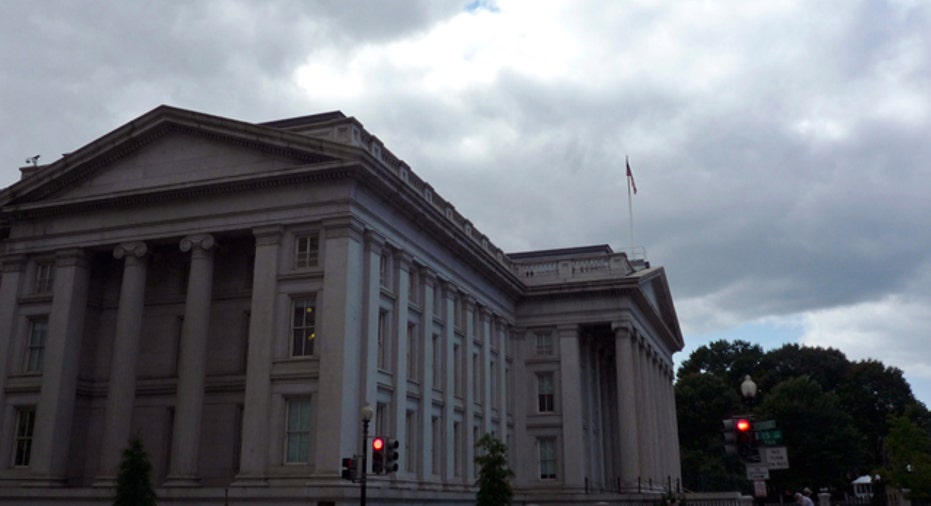How Treasury Could Prevent Hitting the Debt Ceiling

A temporary suspension of the U.S. debt ceiling expires on May 19, but the Treasury Department should be able to borrow for several more months by employing unusual cash management tools.
The department believes these tools and surprisingly strong government revenues should allow it to keep paying the nation's bills into September, staving off for a time the specter of a potentially devastating debt default.
Indeed, many private forecaster now believe the debt limit will not become binding until some time in October, in part due to sizable bailout payments from mortgage finance firms Fannie Mae and Freddie Mac. The cash infusion will provide the government more room to operate.
The Treasury is likely to start taking steps that will hold off default in the coming days.
Following are some of the measures the Treasury has employed in the past and will likely use this time around to free up borrowing capacity once the temporary suspension of the U.S. debt limit expires.
SUSPEND STATE, LOCAL GOVERNMENT SECURITIES
The Treasury has the authority to suspend sales of State and Local Government Series securities - known as ``slugs'' - which are special low-interest Treasury securities offered to state and local governments to temporarily invest proceeds from municipal bond sales. Slugs, which count against the debt limit, have been suspended several times over the last 20 years to avoid hitting the debt ceiling. Taking this action allows Treasury to issue less debt. The bonds account for about $4 billion to $17 billion of the government's debt issuance per month.
CIVIL SERVICE RETIREMENT AND DISABILITY FUND
The Treasury may suspend investments in the Civil Service Retirement and Disability Fund, a government employee pension funds and redeem existing Treasury securities held by that fund as investments. By law, the fund must be made whole upon a debt limit increase.
GOVERNMENT SECURITIES INVESTMENT FUND
To give the government more time to pay its bills, Treasury can suspend reinvestments in another federal employee pension fund known as the G-Fund. Normally the money market-like retirement fund reinvests its entire balance daily into special-issue Treasury securities that count against the debt limit. Halting reinvestments would instantly claw back some borrowing capacity, but the Treasury must replenish the fund with any lost earnings once a debt limit impasse ends. Federal retirees and employees would be unaffected by this action.
EXCHANGE STABILIZATION FUND
The Treasury could dip into this seldom-used fund earmarked to stabilize currency rates and access the dollar balance to avoid debt issuance. Created during the Great Depression to contribute to exchange rate stability, the fund was used in March 2011 when Group of Seven nations intervened to halt a surge in the yen after Japan was struck by an earthquake. It was also employed as a backstop to guarantee money market mutual funds during the financial crisis from September 2008 to September 2009. The Treasury would not have to restore lost interest earnings to the fund.
ISSUE MORE CASH MANAGEMENT BILLS
The Treasury could cut issuance of longer-term government debt and rely more heavily on short-term cash management bills to gain more day-to-day control over debt outstanding. Cash management bills are typically issued for days, compared to normal Treasury bill maturities of four weeks to one year. However, this is unlikely to buy much time and officials are wary of making any major shifts in the Treasury's debt issuance calendar, which could upset markets.
SUSPEND SAVINGS BONDS
Treasury secretaries in the past have halted sales of U.S. savings bonds to the public during debt limit impasses, but the Treasury said in the latest 2011 debt limit impasse that this would be of little or no benefit. It would not free up borrowing authority and it would only prevent small amounts of new debt from being issued.
WAP FEDERAL FINANCING BANK DEBT
The Federal Financing Bank can issue up to $15 billion in debt on behalf of other government agencies that is not subject to the debt limit. So the Treasury could exchange FFB debt for other debt to reduce the total amount subject to the limit.
However, the Treasury did not elect to use this measure in the most recent impasse, saying it was of little use because of the very small amounts of obligations available for exchange.